Real Foods are well known in Edinburgh as being the place to go for your last minute emergency hunt for vanilla powder or vegetarian suet. With the Great British Bake-Off back on our screens, we’re pretty busy sorting out that essential semolina for flouring the crust of a ciabatta, tracking down glacé cherries and finding a high quality orange blossom water for madeleines!
We’ve a large range of interesting ingredients for baking and we’re particularly good at sourcing vegan or gluten free alternatives. So here’s our guide to some of our bestselling baking goodies, brilliant replacements and truly inspiring ingredients. You can also find our Rise and Fall of British Baking Infographic here.
On your marks, get set, bake!
Bestselling basics
We consistently sell quite a lot of bicarbonate of soda, baking powder, sea salt, psyllium husks and arrowroot. Why? Because they’re just so gosh darned useful!
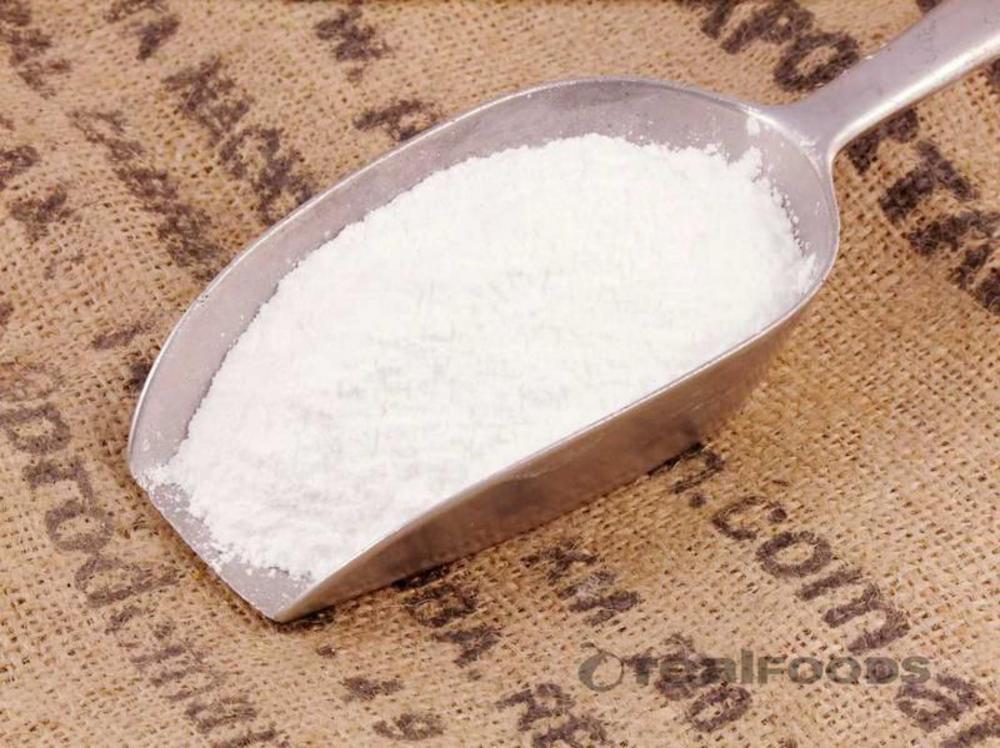 Bicarbonate of soda is an alkali which is used to get a good rise in cakes and soda bread. It needs moisture and an acid to work, it is often combined with buttermilk for soda bread or yoghurt or milk in cakes. Too much bicarb and you’ll get an unpleasant taste and possibly a green tinge to your baking, so use the amount specified in your recipe – or if making your own, go easy on in the bicarb to start with! It works by emitting carbon dioxide to expand the mix, once cooked the carbon dioxide is replaced by air giving you light cakes and breads.
Bicarbonate of soda is an alkali which is used to get a good rise in cakes and soda bread. It needs moisture and an acid to work, it is often combined with buttermilk for soda bread or yoghurt or milk in cakes. Too much bicarb and you’ll get an unpleasant taste and possibly a green tinge to your baking, so use the amount specified in your recipe – or if making your own, go easy on in the bicarb to start with! It works by emitting carbon dioxide to expand the mix, once cooked the carbon dioxide is replaced by air giving you light cakes and breads.
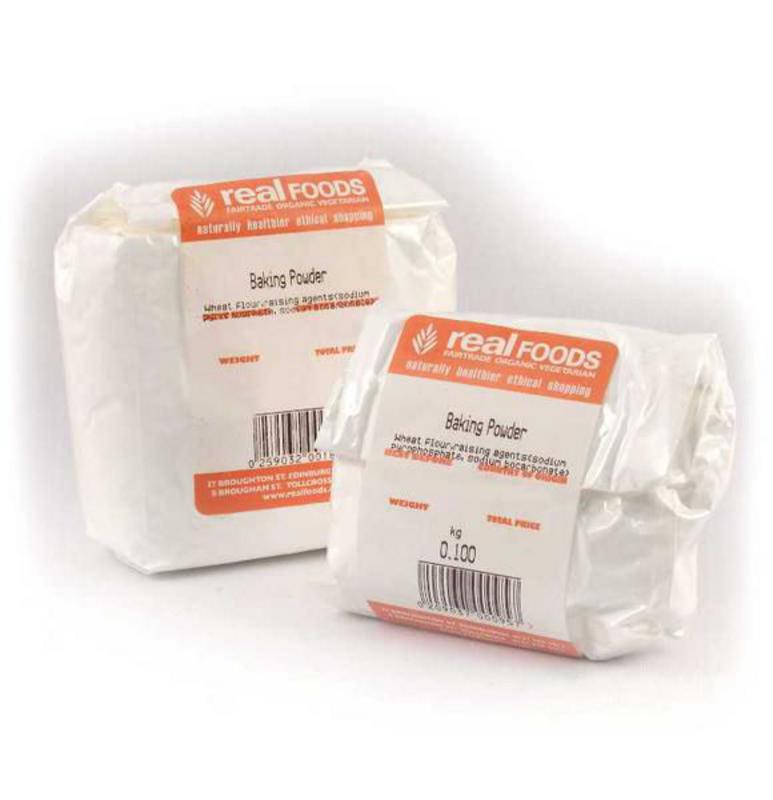 Baking powder is a staple for bakers and features in countless cake recipes. It is created when bicarbonate of soda and cream of tartar, are combined with a filler (such as rice or wheat flour). The alkali bicarb and the acidic cream of tartar react with moisture to create bubbles of carbon dioxide. The big difference between baking powder and bicarbonate of soda, is that it doesn’t require an additional acidic ingredient - it only needs moisture to start releasing air into the mixture. Baking powder also has a neutral taste, so it won’t disturb the balance of flavour in more delicate mixtures.
Baking powder is a staple for bakers and features in countless cake recipes. It is created when bicarbonate of soda and cream of tartar, are combined with a filler (such as rice or wheat flour). The alkali bicarb and the acidic cream of tartar react with moisture to create bubbles of carbon dioxide. The big difference between baking powder and bicarbonate of soda, is that it doesn’t require an additional acidic ingredient - it only needs moisture to start releasing air into the mixture. Baking powder also has a neutral taste, so it won’t disturb the balance of flavour in more delicate mixtures.
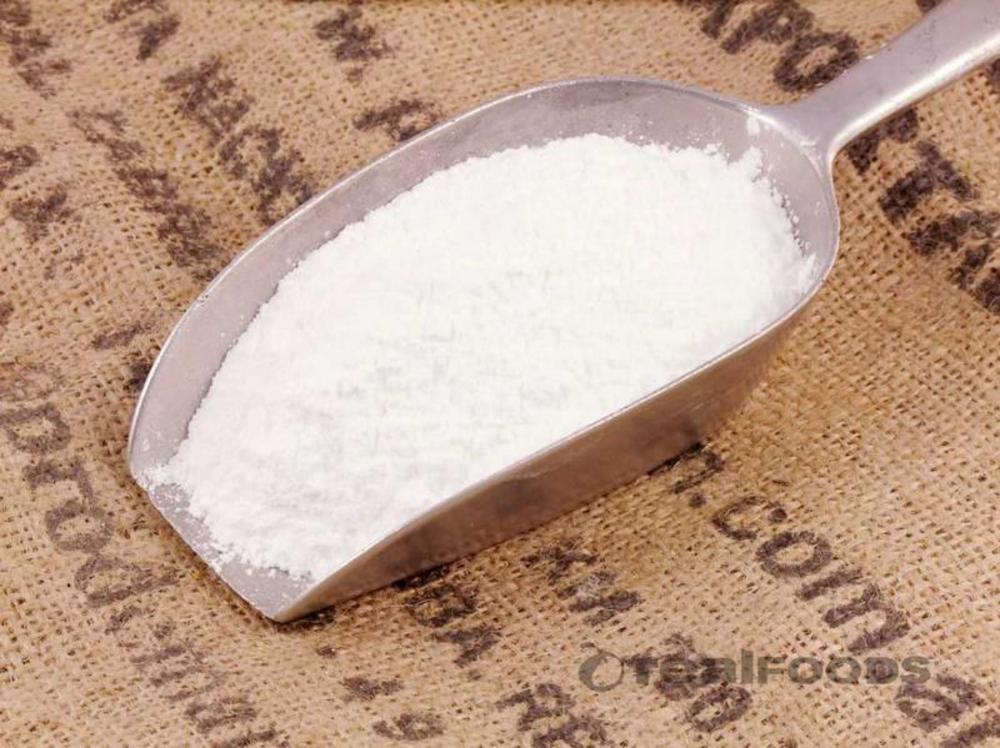 Cream of Tartar. You can make your own baking powder by adding 1/2 teaspoon of bicarbonate to 1/4 of cream of tartar. Cream of tartar is most often used to stabilise egg whites when making meringues. It also increases their tolerance to heat, essential for making a baked Alaska actually work instead of melting into your hot oven! Cream of Tartar has been around for centuries it's a by-product of grape juice fermenting into wine.
Cream of Tartar. You can make your own baking powder by adding 1/2 teaspoon of bicarbonate to 1/4 of cream of tartar. Cream of tartar is most often used to stabilise egg whites when making meringues. It also increases their tolerance to heat, essential for making a baked Alaska actually work instead of melting into your hot oven! Cream of Tartar has been around for centuries it's a by-product of grape juice fermenting into wine.
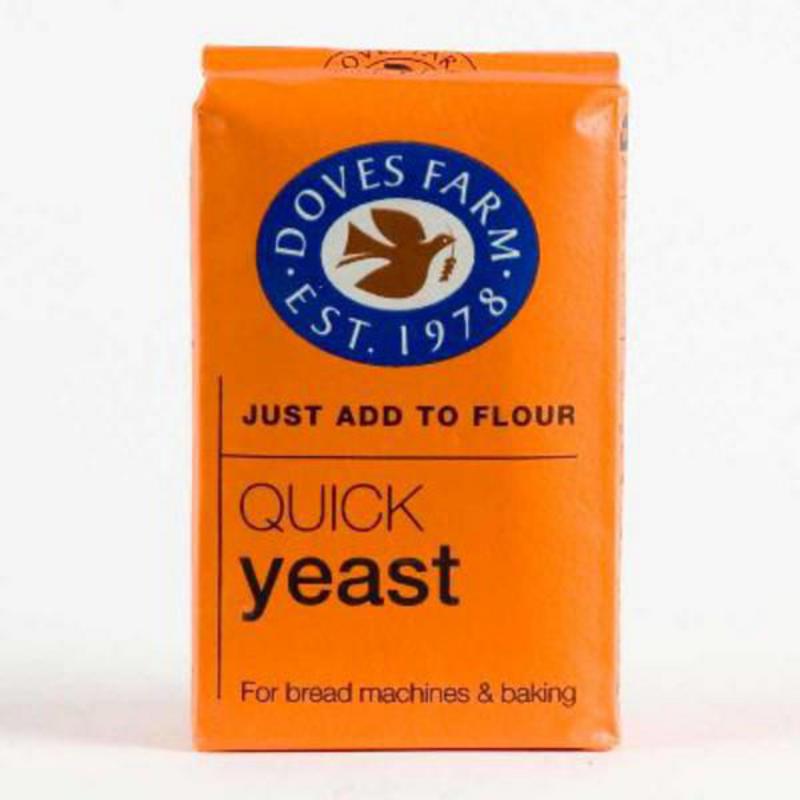 Yeast works through fermentation to leaven (rise) bread and baked goods. We sell both the dry and fresh yeast here at Real Foods. You'll need to live in Edinburgh to get the fresh stuff though, as it lives in the fridge! Dried yeast is whisked into water, the same way fresh yeasts are. We also sell an easybake yeast from Allinsons's and a quick yeast from Doves, that are added directly to the dry ingredients and can be used with bread machines. If using yeast with water, be careful, too cold and it won't activate, too hot and you'll kill it, the optimum temperature is 38C/100F so hotter than your hands but not by much!
Yeast works through fermentation to leaven (rise) bread and baked goods. We sell both the dry and fresh yeast here at Real Foods. You'll need to live in Edinburgh to get the fresh stuff though, as it lives in the fridge! Dried yeast is whisked into water, the same way fresh yeasts are. We also sell an easybake yeast from Allinsons's and a quick yeast from Doves, that are added directly to the dry ingredients and can be used with bread machines. If using yeast with water, be careful, too cold and it won't activate, too hot and you'll kill it, the optimum temperature is 38C/100F so hotter than your hands but not by much!
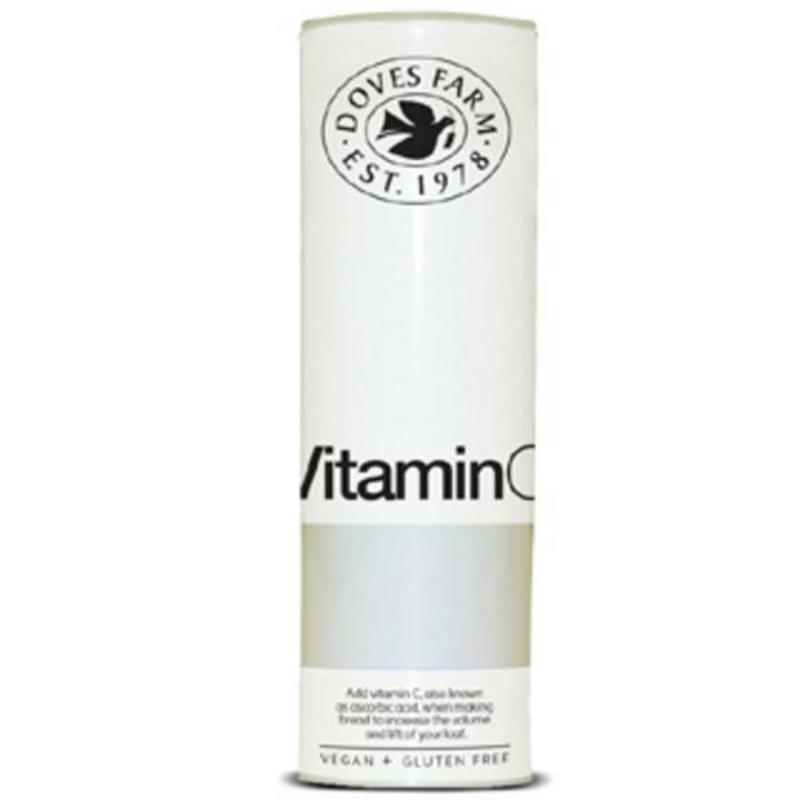 Vitamin C is also known as ascorbic acid. It helps bread to have a light texture and improves the rise, particularly in wholemeal breads. It's thought that it helps to counteract the glutathione that is present in wholemeal flours, which has been known to slow the leavening process. Simply crush a tablet and add it to your mix, you can find all of our vitamin C supplements here, or try the Doves Farm organic vitamin C. Vitamin C is allowed by the Soil Association to be used in organic breadmaking.
Vitamin C is also known as ascorbic acid. It helps bread to have a light texture and improves the rise, particularly in wholemeal breads. It's thought that it helps to counteract the glutathione that is present in wholemeal flours, which has been known to slow the leavening process. Simply crush a tablet and add it to your mix, you can find all of our vitamin C supplements here, or try the Doves Farm organic vitamin C. Vitamin C is allowed by the Soil Association to be used in organic breadmaking.
 Milk powder is often requested, particularly for use in bread machine baking recipes. It is thought to add sweetness to your bread and the milk sugars caramelise giving you a good crust colour. Some bakers disagree and suggest adding whole milk in a liquid form to your bake instead. We sell organic whole milk powder here and also a skimmed milk variety.
Milk powder is often requested, particularly for use in bread machine baking recipes. It is thought to add sweetness to your bread and the milk sugars caramelise giving you a good crust colour. Some bakers disagree and suggest adding whole milk in a liquid form to your bake instead. We sell organic whole milk powder here and also a skimmed milk variety.
Popular Flavours
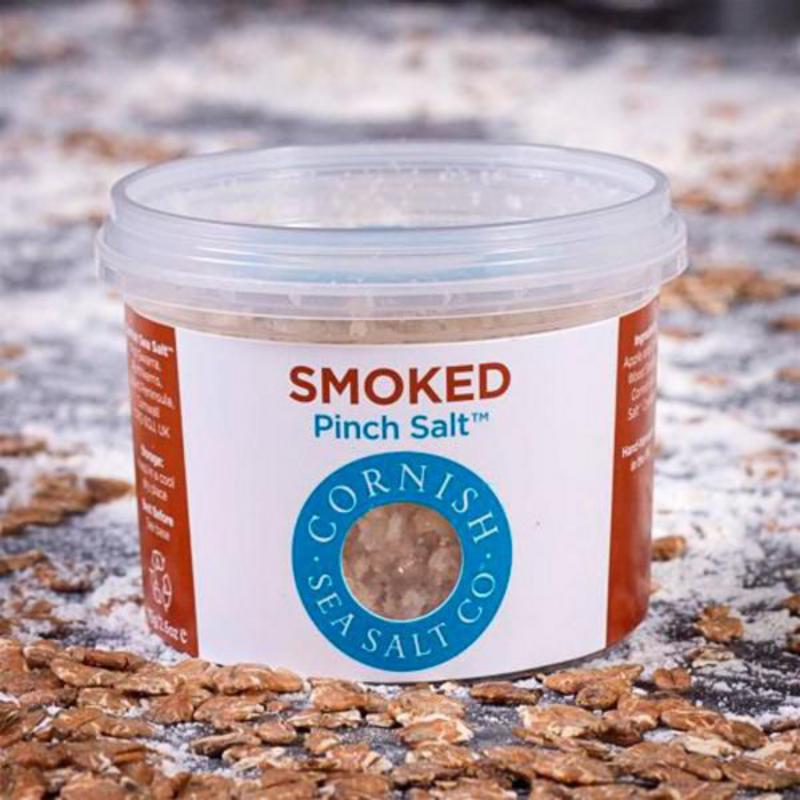 Salt is an essential mineral for the human body, it sharpens the flavour and is important as a preservative. Too much salt has been linked to a host of illnesses though so it makes sense to use a little of the great stuff and use replacements where possible ( try this Vogel salt alternative or a seaweed seasoning mix). We sell huge amounts of our own fine and coarse sea salt, along with the famed Maldon Sea Salt and a variety of Himalayan rock salts (often in pink!) These are used both in baking (usually a fine grain salt to ensure proper mixing and accurate measurements) and as a finishing salt. Most recently the coloured or flavoured salts have been requested for finishing off sweet/sour combinations like salted caramels or smoked salts over chocolate ice cream. They add an incredible depth of flavour to recipes, try a smoked salt to add depth to fudge or chilli smoked salt to add a kick to chocolate muffins. Have a look at our full range of salt and seasoning for inspiration.
Salt is an essential mineral for the human body, it sharpens the flavour and is important as a preservative. Too much salt has been linked to a host of illnesses though so it makes sense to use a little of the great stuff and use replacements where possible ( try this Vogel salt alternative or a seaweed seasoning mix). We sell huge amounts of our own fine and coarse sea salt, along with the famed Maldon Sea Salt and a variety of Himalayan rock salts (often in pink!) These are used both in baking (usually a fine grain salt to ensure proper mixing and accurate measurements) and as a finishing salt. Most recently the coloured or flavoured salts have been requested for finishing off sweet/sour combinations like salted caramels or smoked salts over chocolate ice cream. They add an incredible depth of flavour to recipes, try a smoked salt to add depth to fudge or chilli smoked salt to add a kick to chocolate muffins. Have a look at our full range of salt and seasoning for inspiration.
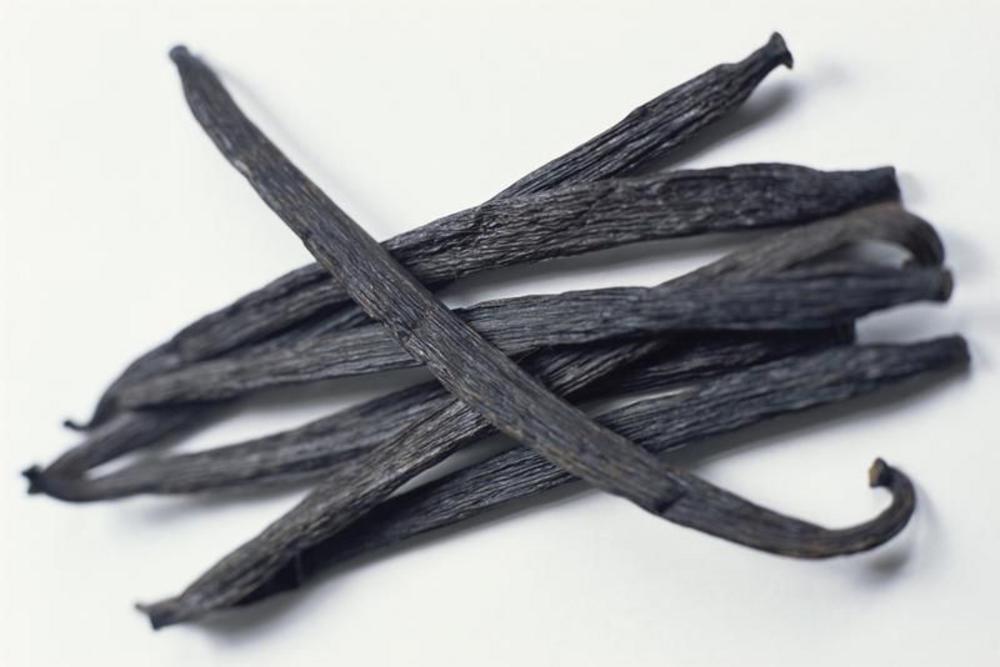 Vanilla is a highly prized ingredient. Vanilla pods contain thousands of tiny black seeds (if you see them in a dish it's confirmation that real vanilla has been used). Vanilla's often used to flavour sugar (pop a pod in the jar with the sugar for a few days and it’s good to go), it’s also widely used to add sweetness and pairs beautifully with chocolate. Here at Real Foods we sell the vanilla pods (including a Fairtrade version), vanilla powder (or an organic one), vanilla extract and even vanilla paste. There's also a vanilla infused coconut sugar here. Even a drop can transform a basic sponge recipe from boring to brilliant!
Vanilla is a highly prized ingredient. Vanilla pods contain thousands of tiny black seeds (if you see them in a dish it's confirmation that real vanilla has been used). Vanilla's often used to flavour sugar (pop a pod in the jar with the sugar for a few days and it’s good to go), it’s also widely used to add sweetness and pairs beautifully with chocolate. Here at Real Foods we sell the vanilla pods (including a Fairtrade version), vanilla powder (or an organic one), vanilla extract and even vanilla paste. There's also a vanilla infused coconut sugar here. Even a drop can transform a basic sponge recipe from boring to brilliant!
 Carob is a natural sweetener and often used as a replacement for chocolate as it has a similar level of sugars and flavours but far less fat, calories and no caffeination. People who are sensitive to the effects of chocolate find it a useful substitute for chocolate or for sugars. We sell carob in powder, flakes and drops for baking (you can get ready-made carob bars here). Try replacing your chocolate drops with carob in your next batch of cookies and see if you like it! Carob pods are also known as locust beans, carob gum is often known as locust bean gum in recipes, it's a thickener and polysaccharide gum that is used in sauces, condiments and ice-creams. It's naturally gluten free so it is a good alternative to using gluten in recipes that need structure.
Carob is a natural sweetener and often used as a replacement for chocolate as it has a similar level of sugars and flavours but far less fat, calories and no caffeination. People who are sensitive to the effects of chocolate find it a useful substitute for chocolate or for sugars. We sell carob in powder, flakes and drops for baking (you can get ready-made carob bars here). Try replacing your chocolate drops with carob in your next batch of cookies and see if you like it! Carob pods are also known as locust beans, carob gum is often known as locust bean gum in recipes, it's a thickener and polysaccharide gum that is used in sauces, condiments and ice-creams. It's naturally gluten free so it is a good alternative to using gluten in recipes that need structure.
 Chocolate. Well to tell the truth we’re a bit obsessed with chocolate here at Real Foods! We sell an extensive range of high quality chocolates (including Fairtrade and organic – have a look in our chocolate shop here) and also have a wide variety of raw chocolates and all the ingredients to make your own. Cacao nibs or beans and powder come in raw and organic varieties, along with cacao liquor (sometimes known as cacao paste or raw cacao mass) which is an absolute must for any chocolate aficionados as it imparts truly glorious flavours. It contains around 55% cocoa butter and 45% pure powder, so to make chocolate all you need to do is melt it gently and add your preferred sweeteners. Easy and amazing! Our cooking chocolate can be found here including the brilliant 100% cacao from Willie’s. Cacao butter can be found here, including our very popular organic, raw cocoa butter. Try adding the nibs to a coffee cake for added depth or use the powder for flavouring.
Chocolate. Well to tell the truth we’re a bit obsessed with chocolate here at Real Foods! We sell an extensive range of high quality chocolates (including Fairtrade and organic – have a look in our chocolate shop here) and also have a wide variety of raw chocolates and all the ingredients to make your own. Cacao nibs or beans and powder come in raw and organic varieties, along with cacao liquor (sometimes known as cacao paste or raw cacao mass) which is an absolute must for any chocolate aficionados as it imparts truly glorious flavours. It contains around 55% cocoa butter and 45% pure powder, so to make chocolate all you need to do is melt it gently and add your preferred sweeteners. Easy and amazing! Our cooking chocolate can be found here including the brilliant 100% cacao from Willie’s. Cacao butter can be found here, including our very popular organic, raw cocoa butter. Try adding the nibs to a coffee cake for added depth or use the powder for flavouring.
 Flavour extracts. Along with the ever popular vanilla extract, we sell other popular flavours like peppermint , almond and lemon. We also have an amazing range from Medicine Flower of raw flavour extracts. Never heated above 118 degrees Fahrenheit they’re alcohol free and highly concentrated. Consistent comparisons with other products on the market have revealed the flavour potency as being over 30-70 times higher (1-5 drops of our flavours equal up to a teaspoon of other flavours). Flavour extracts tend to become far less potent when used at high temperatures, so be careful when you add them to your recipe. They're very useful when you want to add flavour but not the moistness, for example adding an orange flavour to a cake is usually much easier than adding an acidic juice.
Flavour extracts. Along with the ever popular vanilla extract, we sell other popular flavours like peppermint , almond and lemon. We also have an amazing range from Medicine Flower of raw flavour extracts. Never heated above 118 degrees Fahrenheit they’re alcohol free and highly concentrated. Consistent comparisons with other products on the market have revealed the flavour potency as being over 30-70 times higher (1-5 drops of our flavours equal up to a teaspoon of other flavours). Flavour extracts tend to become far less potent when used at high temperatures, so be careful when you add them to your recipe. They're very useful when you want to add flavour but not the moistness, for example adding an orange flavour to a cake is usually much easier than adding an acidic juice.
 Rosewater and Orange Water. Rosewater has been used as a flavouring for centuries in Middle Eastern, Indian and Chinese cuisine. It can be added to jellies and syrups, and it is often sprinkled over cakes and milky puddings such as kheer (Indian rice pudding). Orange Flower Water is used in madeleines and for flavouring marzipan, it’s also very popular in Middle Eastern recipes, particularly Lebanese.
Rosewater and Orange Water. Rosewater has been used as a flavouring for centuries in Middle Eastern, Indian and Chinese cuisine. It can be added to jellies and syrups, and it is often sprinkled over cakes and milky puddings such as kheer (Indian rice pudding). Orange Flower Water is used in madeleines and for flavouring marzipan, it’s also very popular in Middle Eastern recipes, particularly Lebanese.
Flours
Gluten is a natural protein and is what gives bread and pastries their structure. High-protein hard wheats have a high gluten content and softer low-protein wheats a lower one.
Wheat flour is one of the most popular flours to bake bread with. There’s a huge variety of wheat flours available, for breadmaking, their gluten content is usually how you’ll distinguish between them. Flours marked strong, very strong, BioBake or bread flour will produce excellent crusty breads, rolls and pizza doughs. Wholemeal flour contains more fibre and nutrients.
Our bestselling wheat flours are strong wholemeal bread flour, extra strong wholemeal bread flour, stoneground wholemeal biobake flour and extra strong white flour. Strong flour is also excellent for choux and hot water pastry.
What is biobake?
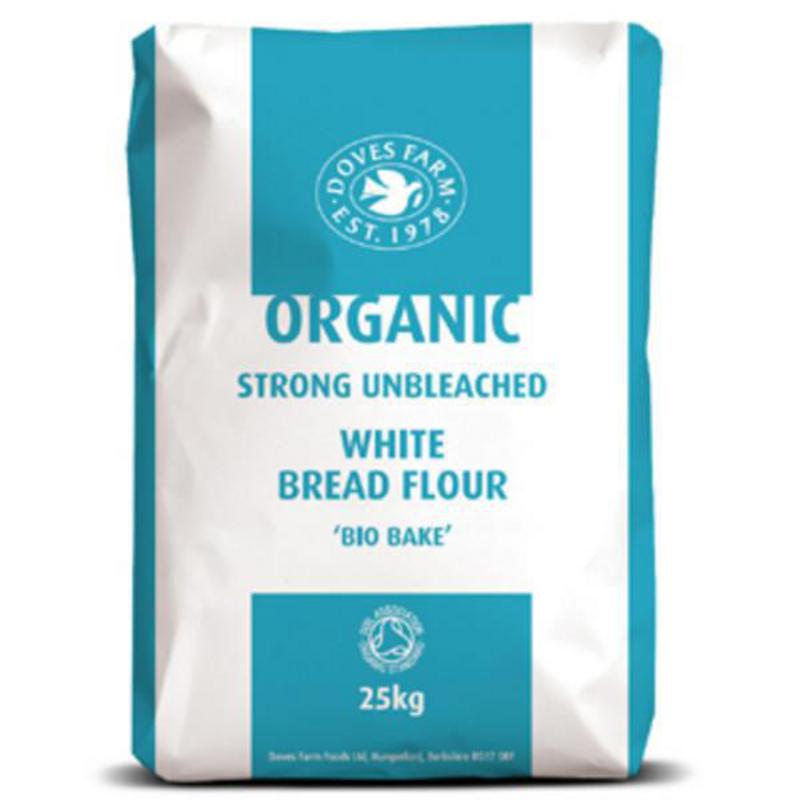 BioBake is a trademark of Doves Farm Foods and is an organic high gluten flour for professional bakery use. It is Soil Association certified and does not include any fungal, or enzyme derived additives. Doves Farm Foods were very concerned to learn that Kerry Foods had applied the Biobake name to a range of highly refined bakery additives which are diametrically opposite to the credentials of their company, organic flour and other organic foods. Real Foods ONLY sell the Doves Farm biobake products not the Kerry Foods, we are keen to support artisan and wholefood bakers and do not promote highly refined unnecessary additives. We sell the wholemeal stoneground and the strong white BioBake flours.
BioBake is a trademark of Doves Farm Foods and is an organic high gluten flour for professional bakery use. It is Soil Association certified and does not include any fungal, or enzyme derived additives. Doves Farm Foods were very concerned to learn that Kerry Foods had applied the Biobake name to a range of highly refined bakery additives which are diametrically opposite to the credentials of their company, organic flour and other organic foods. Real Foods ONLY sell the Doves Farm biobake products not the Kerry Foods, we are keen to support artisan and wholefood bakers and do not promote highly refined unnecessary additives. We sell the wholemeal stoneground and the strong white BioBake flours.
Italian Flours, type 0, type 00
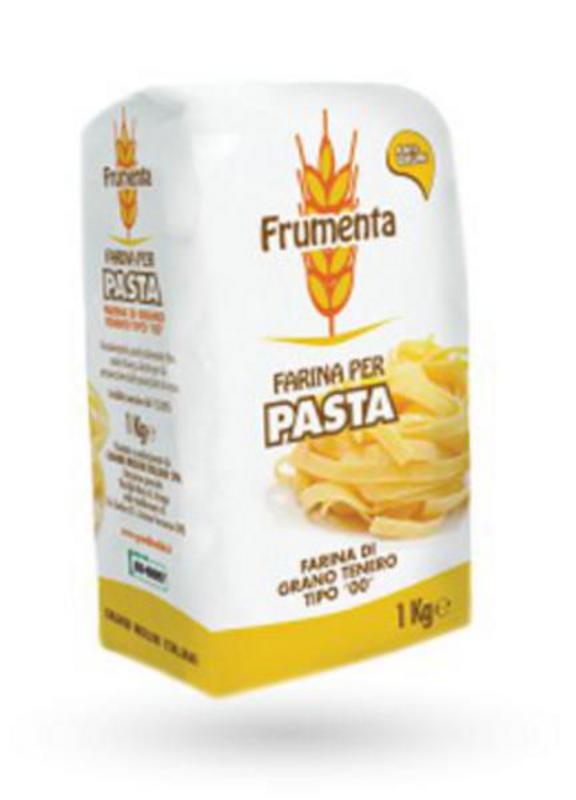 Italy rates its flours by a 0 rating. One zero means it is quite coarse in texture, like very powdery semolina, everyday flour is usually classed as double zero, or ‘00’ and triple zero is much finer like cornstarch. We sell the 00 which is suitable for making pasta here or an organic 00 here. In cake recipes it can be replaced with plain flour; in bread, pizza and pasta recipes it can be replaced with strong white bread flour. It is often lower in protein than British flours and so produces a much crisper crust in bread, and a finer texture in cakes. Doves Farm make a pasta and pizza flour, which is closer to type 0. Gilchesters also produce a pizza and ciabatta flour which has added semolina to give a richer taste. Frumenta also have a traditional type 0 for pizza here.
Italy rates its flours by a 0 rating. One zero means it is quite coarse in texture, like very powdery semolina, everyday flour is usually classed as double zero, or ‘00’ and triple zero is much finer like cornstarch. We sell the 00 which is suitable for making pasta here or an organic 00 here. In cake recipes it can be replaced with plain flour; in bread, pizza and pasta recipes it can be replaced with strong white bread flour. It is often lower in protein than British flours and so produces a much crisper crust in bread, and a finer texture in cakes. Doves Farm make a pasta and pizza flour, which is closer to type 0. Gilchesters also produce a pizza and ciabatta flour which has added semolina to give a richer taste. Frumenta also have a traditional type 0 for pizza here.
Semolina is produced from hard durum wheat, which then has the fine flour sifted out. Semolina is what gives ciabatta its colour and texture on the outside of the loaf. Semolina is also widely used in pasta making.
Plain flour is made from softer wheat varieties and is good for scones, pastry and sauces.
Gluten Free Flours
There's a huge range of Gluten Free flours and baking ingredients available. Products that are certified Gluten Free have been (and continue to be) batch-tested to ensure their gluten content is less than 20 PPM (parts per million). Products that are naturally gluten free (i.e. don't have any gluten containing ingredients) that are not certified, have either not been batch tested or show cross contamination warnings. For example, our own brand Organic Buckwheat Flour is naturally gluten free, but as it has cross contamination warnings regarding the storage of it (the manufacturer's neighbours produce wheat), it is NOT certified Gluten Free. This means that if you are avoiding gluten, or simply wanting to try out buckwheat flour, this product is suitable. However, if you are baking for someone suffering from coeliac disease (or indeed are coeliac yourself), you need to get the certified gluten free buckwheat flour to ensure no gluten above 20 PPM. Certified products should have Gluten Free clearly showing in their product name. We take our allergen labelling extremely seriously, if you have any questions or think an item is labelled incorrectly please get in touch with us at webshop@realfoods.co.uk and we'll do our best to help. For more information on Gluten Free diets follow this link.
 Amaranth Flour - made from the incredibly nutritious amaranth seed, it has a nutty flavour and aroma . It is naturally gluten free but does have a fairly high starch content so it’s good for sticking things together in baking. It’s usually quite coarsely textured so it’s recommended for use with finer flours to provide a balance.
Amaranth Flour - made from the incredibly nutritious amaranth seed, it has a nutty flavour and aroma . It is naturally gluten free but does have a fairly high starch content so it’s good for sticking things together in baking. It’s usually quite coarsely textured so it’s recommended for use with finer flours to provide a balance.
 Ground Almonds – used for making frangipane, almond macaroons and often in cake or pie fillings. It adds a rich, nutty taste to baked goods and also adds moistness. It’s widely used for quick baking (it’s nigh on impossible to knead), for almond flour you can blitz the ground almonds further – however not too far or you’ll end up with almond nut butter! Ground almonds are also known as almond meal. Ground almonds are used in flourless chocolate cake or brownie mixes often, as the almonds go particularly well with a rich cocoa taste.
Ground Almonds – used for making frangipane, almond macaroons and often in cake or pie fillings. It adds a rich, nutty taste to baked goods and also adds moistness. It’s widely used for quick baking (it’s nigh on impossible to knead), for almond flour you can blitz the ground almonds further – however not too far or you’ll end up with almond nut butter! Ground almonds are also known as almond meal. Ground almonds are used in flourless chocolate cake or brownie mixes often, as the almonds go particularly well with a rich cocoa taste.
 Corn - Cornflour is the powdery, white starch from maize (corn). It’s often called cornstarch in American recipes. It’s used for thickening (soup, gravy, custard etc.) and is also used in gluten free baking, it’s similar to arrowroot. There is a certified gluten free cornflour starch from Doves here. There is also Infinity’s Corn Flour which is simply cornmeal or a fairly coarse flour made from maize that is used for making tortillas and cornbread. If you prefer a rougher textured flour (say, for making polenta) then you’ll need maizemeal - sometimes called maizemeal polenta. Or try this raw purple corn flour from Raw Living to add colour and nutrition to baking.
Corn - Cornflour is the powdery, white starch from maize (corn). It’s often called cornstarch in American recipes. It’s used for thickening (soup, gravy, custard etc.) and is also used in gluten free baking, it’s similar to arrowroot. There is a certified gluten free cornflour starch from Doves here. There is also Infinity’s Corn Flour which is simply cornmeal or a fairly coarse flour made from maize that is used for making tortillas and cornbread. If you prefer a rougher textured flour (say, for making polenta) then you’ll need maizemeal - sometimes called maizemeal polenta. Or try this raw purple corn flour from Raw Living to add colour and nutrition to baking.

Rice Flour – can be used for thickening sauces, stews and soups or for cake and breadmaking. It has a grainy texture so is best used in conjunction with other flours to get a better texture. It’s often used in shortbread or cookies. We mainly sell brown rice flour, but also have a mixed brown and white rice stoneground from Doves.
 Oat Flour – a delicate flour made from rolled oats. We sell a certified Gluten Free version from Bob’s Red Mill or if you want more texture try the fine oatmeal. Our oatmeals are naturally gluten free but often have cross contamination warnings, if you want certified gluten free oats follow this link.
Oat Flour – a delicate flour made from rolled oats. We sell a certified Gluten Free version from Bob’s Red Mill or if you want more texture try the fine oatmeal. Our oatmeals are naturally gluten free but often have cross contamination warnings, if you want certified gluten free oats follow this link.
Starches, Vegetable Gums and Pectin
Root Starches
Root starches need only a little cooking to remove the starchy flavour and impart a high glossy, translucent sheen to sauces, gravies and pie fillings. They have a silky texture. To avoid lumps, mix with an equal amount of cold liquid and then add to the sauce or liquid you wish to thicken. Root starches are naturally gluten free, however if you are coeliac or have serious allergies you will need products certified gluten free. These flours are also used in gluten free baking, for example as 1 part to 2 or 3 parts rice of buckwheat flour to give a good base flour.
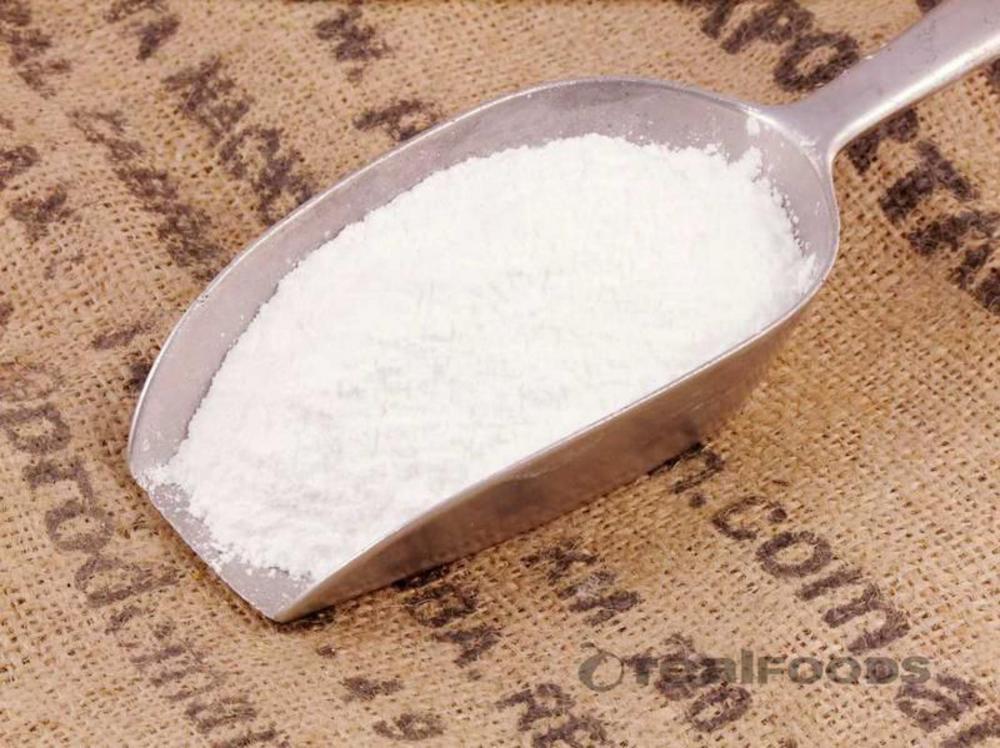
Arrowroot looks and feels like cornstarch. It’s a thickener and is used for sauces and gravies along with fruit pie fillings, puddings and glazes. When heated the starch turns to jelly and thickens the liquid. Arrowroot does not breakdown with acidic ingredients (which is why it’s so useful for fruity glazes or dessert sauces). It is tasteless, so it will pick up the flavours of your filling or glaze without adding anything and is often recommended for making homemade ice-cream as it interferes with the formation of large ice crystals and is not affected by freezing. It is not good for gravies or fruit pies filling as it thickens long before the boiling point has been reached.
 Potato starch flour is extracted from the potato, a tuber. This is a root starch that gelatinises at relatively low temperatures (compared to corn or wheat starches). It’s best used towards the end of cooking as it doesn’t need much cooking. It’s often used to thicken soups and gravies. Don’t boil, it will lose its power to thicken. Potato starch is a permitted ingredient at Passover (unlike cornstarch and grain-based ingredients). For more information on the difference between potato starch flour and potato flour (and how to make your own potato flour), please follow this link. Certified gluten free potato starch flour is available from Doves or Infinity Foods.
Potato starch flour is extracted from the potato, a tuber. This is a root starch that gelatinises at relatively low temperatures (compared to corn or wheat starches). It’s best used towards the end of cooking as it doesn’t need much cooking. It’s often used to thicken soups and gravies. Don’t boil, it will lose its power to thicken. Potato starch is a permitted ingredient at Passover (unlike cornstarch and grain-based ingredients). For more information on the difference between potato starch flour and potato flour (and how to make your own potato flour), please follow this link. Certified gluten free potato starch flour is available from Doves or Infinity Foods.
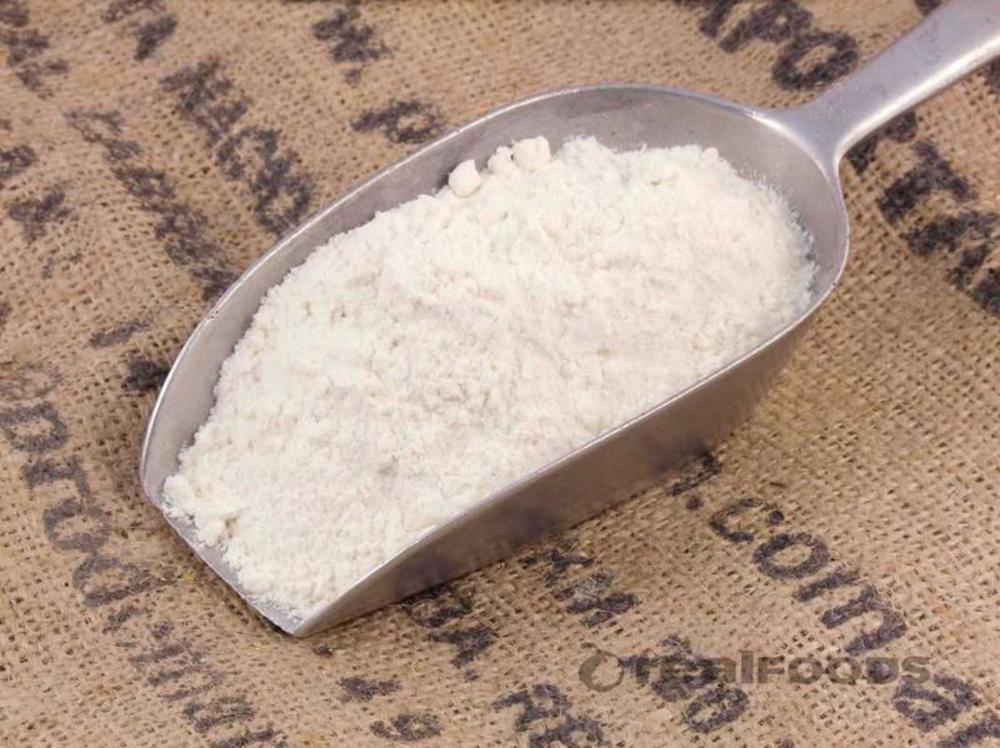 Tapioca Flour is taken from the cassava root (also known as manioc or yucca) – it’s sometimes known as Manioc Starch or Tapioca Starch. It is often used for fruit pie fillings and glazes as it leaves a high gloss and a smooth finish. It’s popular in Asian cuisine and is used commonly instead of cornstarch (cornflour). Certified gluten free tapioca flour is available from Doves and Infinity Foods. Tapioca flour is an excellent choice for making ice-cream as it remains stable when frozen and is essential for a lot of South American recipes.
Tapioca Flour is taken from the cassava root (also known as manioc or yucca) – it’s sometimes known as Manioc Starch or Tapioca Starch. It is often used for fruit pie fillings and glazes as it leaves a high gloss and a smooth finish. It’s popular in Asian cuisine and is used commonly instead of cornstarch (cornflour). Certified gluten free tapioca flour is available from Doves and Infinity Foods. Tapioca flour is an excellent choice for making ice-cream as it remains stable when frozen and is essential for a lot of South American recipes.
 Kuzu or Kudzu is a root vine that grows in the mountains of Japan. It's a great thickener for soups and stews, sweet and savoury sauces, glazes and pie fillings. To thicken a liquid, crush the chunks into a powder, mix them with an equal amount of cold water, then stir the mixture into the hot liquid and simmer for a few minutes until the sauce is thickened. A half to one tablespoon of kuzu will thicken one cup of liquid for sauces and gravies, you'll need more like 2 tablespoons per cup for a jelly. It’s also traditionally used to relieve digestive problems (by creating an alkaline condition in the digestive tract), and is believed to suppress a desire for alcohol.
Kuzu or Kudzu is a root vine that grows in the mountains of Japan. It's a great thickener for soups and stews, sweet and savoury sauces, glazes and pie fillings. To thicken a liquid, crush the chunks into a powder, mix them with an equal amount of cold water, then stir the mixture into the hot liquid and simmer for a few minutes until the sauce is thickened. A half to one tablespoon of kuzu will thicken one cup of liquid for sauces and gravies, you'll need more like 2 tablespoons per cup for a jelly. It’s also traditionally used to relieve digestive problems (by creating an alkaline condition in the digestive tract), and is believed to suppress a desire for alcohol.
Other Thickeners

Psyllium husks are both a bestseller and fairly tricky to find in mainstream stores. They are widely used in gluten free baking, generally in baked goods that usually rely on gluten such as rolls, pasta or pizza dough. Psyllium husks bind moisture and help make baking less crumbly. They absorb up to 20 times their own weight in water and are a source of soluble dietary fibre so they are also used by people as a dietary supplement. Psyllium husks are often used to replace guar or xanthan gums in baking.
Vegetable Gums
Vegetable gums are used to preserve, stabilise, alter the texture, emulsify, or thicken ingredients.
 Agar
Agar is a traditional Japanese gelling agent made from sea vegetables. It is a vegetarian and vegan substitute for gelatine. One tablespoon of agar will gelatinise 240mls. You simply heat your mixture and add roughly a tablespoon of flakes per cup of liquid. Simmer for 3-5 minutes and it can be poured into a mould and set. Great for jellies, aspics and desserts. In substituting agar for gelatin, remember that agar may not set when mixed with vinegar or foods high in oxalic acid, like spinach, chocolate, or rhubarb. Agar gelled liquids will stay solid at room temperature, while gelatin will eventually melt.
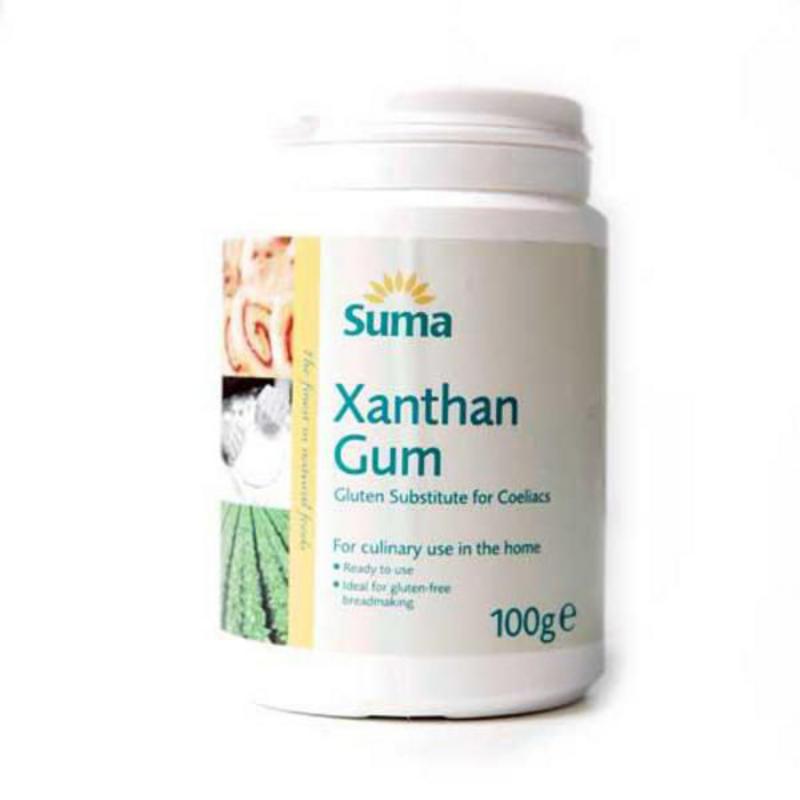 Xanthan Gum
Xanthan Gum is created from fermenting glucose or sucrose with Xanthomonas Campestris. It derives its name from the strain of bacteria used to ferment it. It is widely used in gluten free baking to achieve the 'stickiness' that gluten free goods often lack. When xanthan gum is combined with water, it binds and forms a highly viscous gel. This viscosity makes xanthan gum useful in enhancing the appearance, texture and stability of food.
 Organic Locust Bean Gum
Organic Locust Bean Gum is derived from the seeds of the carob plant. It is a gluten replacement option in many food products and recipes that would normally require flour. It is also been reported to lower cholesterol of the blood. Carob bean gum is a natural polysaccharide thickener or gum that is used in many food products, such as sauces, dressings, cheese, condiments and ice cream. It is a versatile ingredient that can thicken products at hot or cold temperatures. It is described chemically as galactomannan and is particularly useful in dairy recipes. in order for it to gel it needs to be used in conjunction with xanthan gum, agar or carrageenan.
Fruit and vegetables
Dried fruit is a popular addition to many cakes, desserts and biscuits and obviously it’s of prime importance in a variety of Christmas recipes. Dried fruits retain most of their nutritional value and add sweetness, moistness and flavour to a lot of dishes. They’re often rehydrated by adding liquid for about 10 - 15 minutes before cooking, or they pick up the moisture from the recipe itself. Try soaking dried raisins in orange juice and it’ll add a new flavour layer to your dish.
We have an extensive list of dried fruits here at Real Foods (have a look at our full range here) but here are some of our bestsellers, essentials and old favourites.
 Ginger. Dried ginger is often used in baking, the fresh and ground ginger is used in a variety of Asian dishes but when it comes to baking it’s most often the crystallised ginger pieces or stem ginger in syrup that’s used. Just think of making gingerbread without it! We have crystallised ginger in raw cane sugar here, or dried ginger pieces here. We also sell stem ginger in syrup, you can find the crushed ginger in syrup here, ginger balls in syrup here or even ginger shavings in syrup. If you’re making ginger snaps however, it’s the ground ginger you’re probably looking for.
Ginger. Dried ginger is often used in baking, the fresh and ground ginger is used in a variety of Asian dishes but when it comes to baking it’s most often the crystallised ginger pieces or stem ginger in syrup that’s used. Just think of making gingerbread without it! We have crystallised ginger in raw cane sugar here, or dried ginger pieces here. We also sell stem ginger in syrup, you can find the crushed ginger in syrup here, ginger balls in syrup here or even ginger shavings in syrup. If you’re making ginger snaps however, it’s the ground ginger you’re probably looking for.
 Dates. We sell a LOT of dates. Why? Because they add a rich, chewy sweetness to recipes that few other ingredients can match. We sell both fresh and dried, Medjool are great for their almost toffee-like taste. Try stuffing one with an almond and rolling in icing sugar for an impressive nibble. Dates are widely used in raw recipes also. Here's a link to fresh medjool dates. Free flow dates are ones which are unpressed, so they do not clump. We also have pre-chopped dates, rolled in rice flour to prevent sticking together and an organic version also. One of our most popular products is simply organic pitted dates, you can find them here.
Dates. We sell a LOT of dates. Why? Because they add a rich, chewy sweetness to recipes that few other ingredients can match. We sell both fresh and dried, Medjool are great for their almost toffee-like taste. Try stuffing one with an almond and rolling in icing sugar for an impressive nibble. Dates are widely used in raw recipes also. Here's a link to fresh medjool dates. Free flow dates are ones which are unpressed, so they do not clump. We also have pre-chopped dates, rolled in rice flour to prevent sticking together and an organic version also. One of our most popular products is simply organic pitted dates, you can find them here.
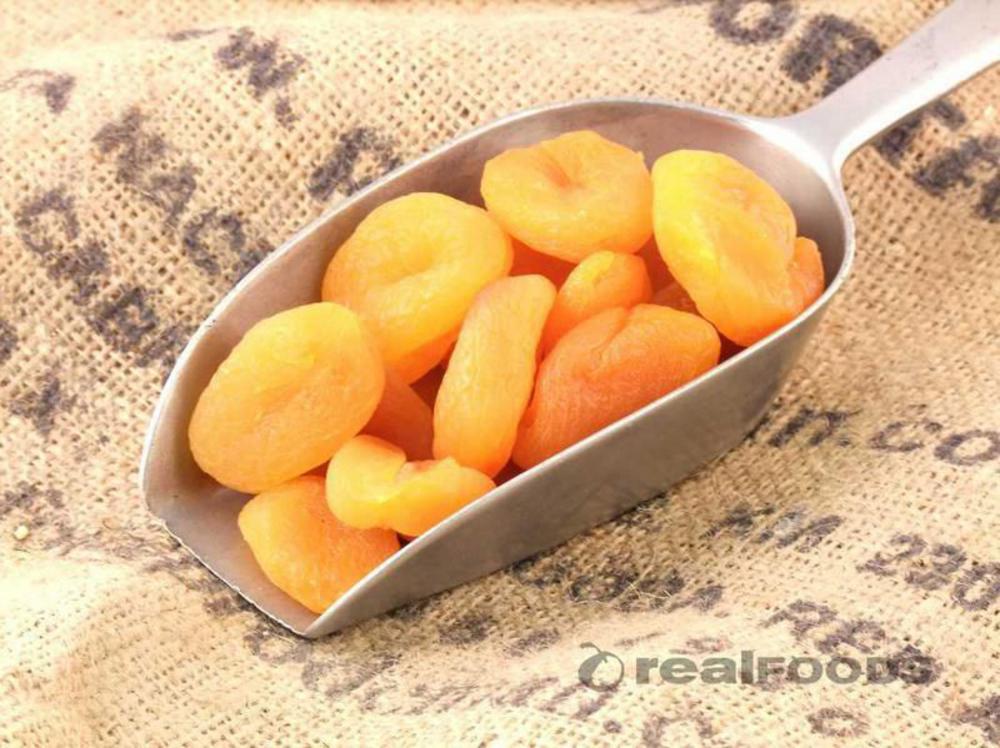 Apricots. Both fresh and dried apricots are widely used in recipes. Baking apricots is always popular (particularly for fresh ones on the wane). Baking them turns them soft and almost jammy and the beautiful sweet/sour taste of apricots makes them very popular for fruit sauces and glazes. We have ready-to-eat apricots here (no soaking required, so be careful, they're well known for being so tasty they never make it to the kitchen!) Pre-chopped apricots are easy to use whilst our most popular remains the unsulphured apricots from Turkey, sweet, plump and almost tangy in flavour. You can also find hunza apricots.
Apricots. Both fresh and dried apricots are widely used in recipes. Baking apricots is always popular (particularly for fresh ones on the wane). Baking them turns them soft and almost jammy and the beautiful sweet/sour taste of apricots makes them very popular for fruit sauces and glazes. We have ready-to-eat apricots here (no soaking required, so be careful, they're well known for being so tasty they never make it to the kitchen!) Pre-chopped apricots are easy to use whilst our most popular remains the unsulphured apricots from Turkey, sweet, plump and almost tangy in flavour. You can also find hunza apricots.
 Fresh fruit and veg work in baking also (as anyone who’s ever eaten carrot cake will assure you!) There are some amazingly tasty cakes involving root vegetables, try this chocolate almond beetroot cake recipe if you need some convincing. Colourful, sweet vegetables like carrots, beetroot and pumpkins add flavour and texture, but they can also reduce the butter or oil you add by up to half. Adding a little fruit will increase the sweetness if you’re trying to avoid sugar.
Fresh fruit and veg work in baking also (as anyone who’s ever eaten carrot cake will assure you!) There are some amazingly tasty cakes involving root vegetables, try this chocolate almond beetroot cake recipe if you need some convincing. Colourful, sweet vegetables like carrots, beetroot and pumpkins add flavour and texture, but they can also reduce the butter or oil you add by up to half. Adding a little fruit will increase the sweetness if you’re trying to avoid sugar.
Carrots work well with walnuts and are perked up by many spices, particularly cinnamon, cardamom or nutmeg.
Beetroot is brilliant with chocolate and dates. You don’t need to cook it first, simply grate it finely into your baked goods and it will add a lovely earthiness to your cooking. It’s also a natural food colouring.
Sweet potato pairs well with ginger and macadamia nuts and is a great addition to muffins and pies.
Courgettes and other squashes are great for adding moisture; leave the skin on as it adds colour and extra vitamins.
Apples are very popular baking fruit along with pears. Grate them into the mixture to add sweetness or leave chunks to add a burst of flavour.
Rhubarb is popular to balance out sweet flavours, its tartness cuts through and adds depth to dishes.
The juice of citrus fruit is often used to add a certain zing to cakes. The zest is particularly flavoursome.